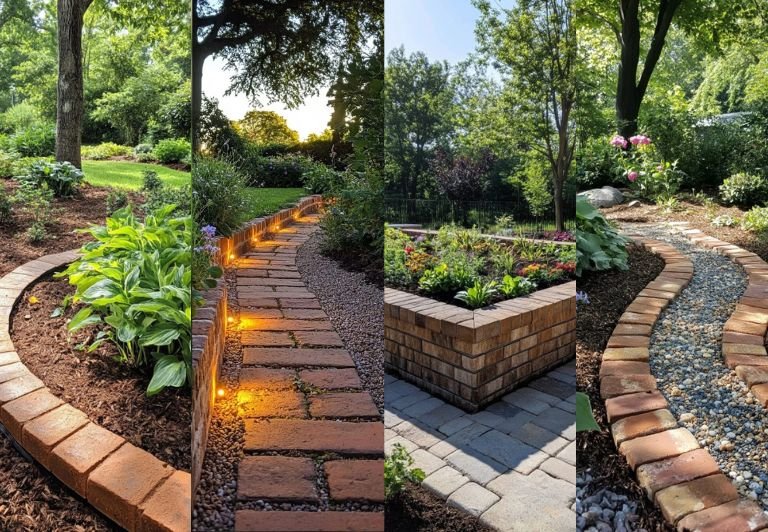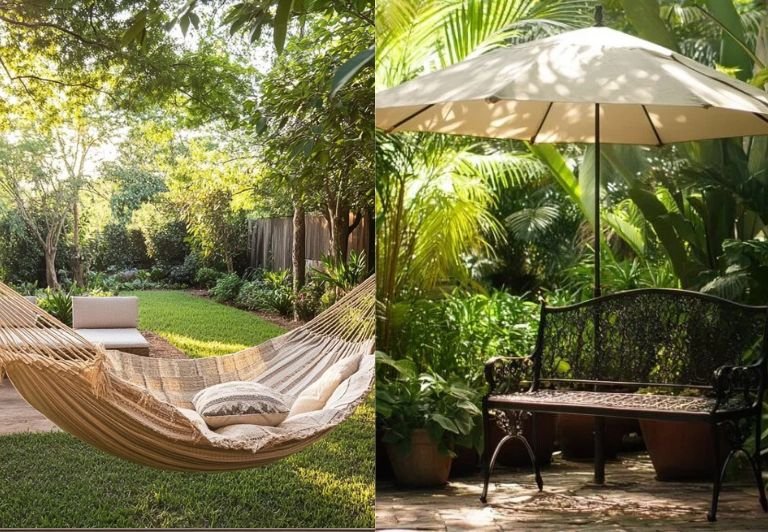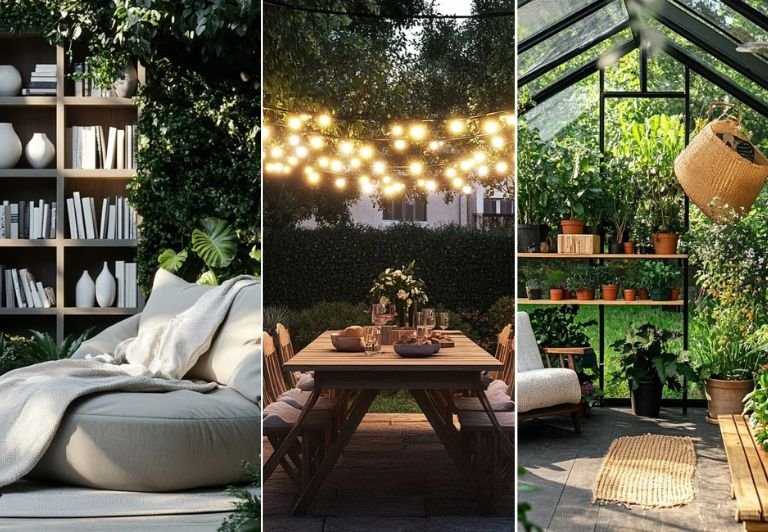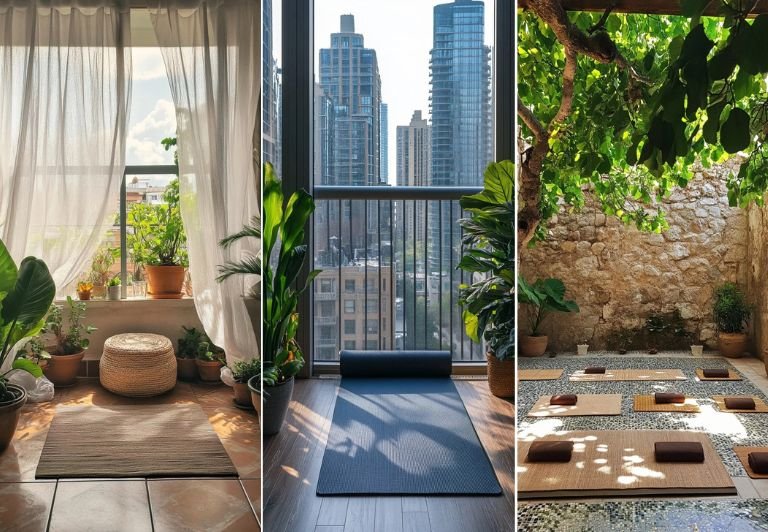20 how to lay brick border garden edging to affordably frame your garden
A brick border is one of the simplest yet most effective ways to give your garden clean lines, a polished look, and long-lasting durability. Whether you’re framing flower beds, defining pathways, or adding structure to your lawn, brick edging can add a timeless, classic feel to your outdoor space.
The good news? Laying a brick border doesn’t have to be intimidating. With the right tools, a bit of patience, and some smart planning, you can achieve a neat, professional finish that truly elevates your landscape.
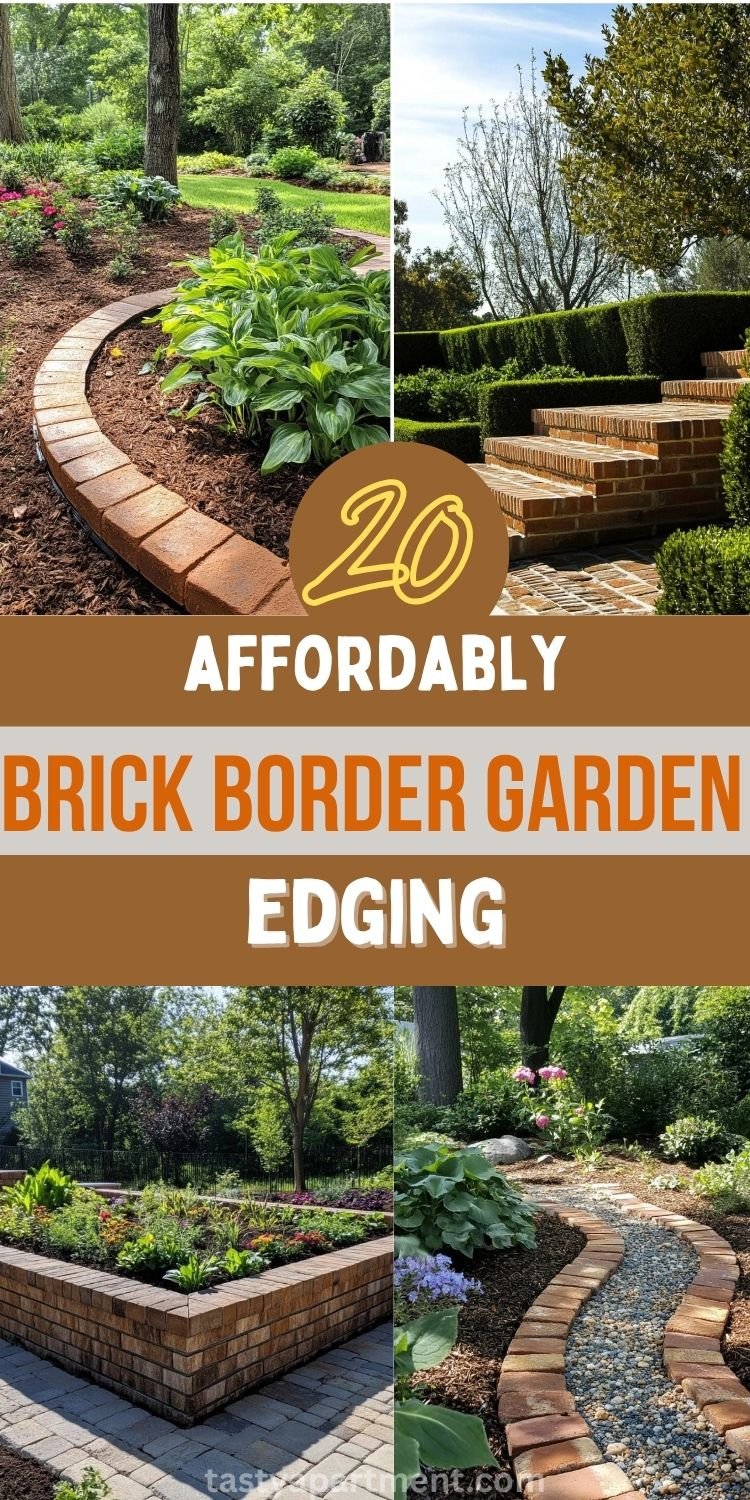
In this guide, you’ll find 20 essential tips on how to lay a brick border for garden edging, from prepping your trench to leveling bricks and securing them in place. Get ready to transform your yard with a touch of classic charm and expert know-how.
20 how to lay brick border garden edging
1. Classic Brick Edging Around Flower Bed with Curved Layout
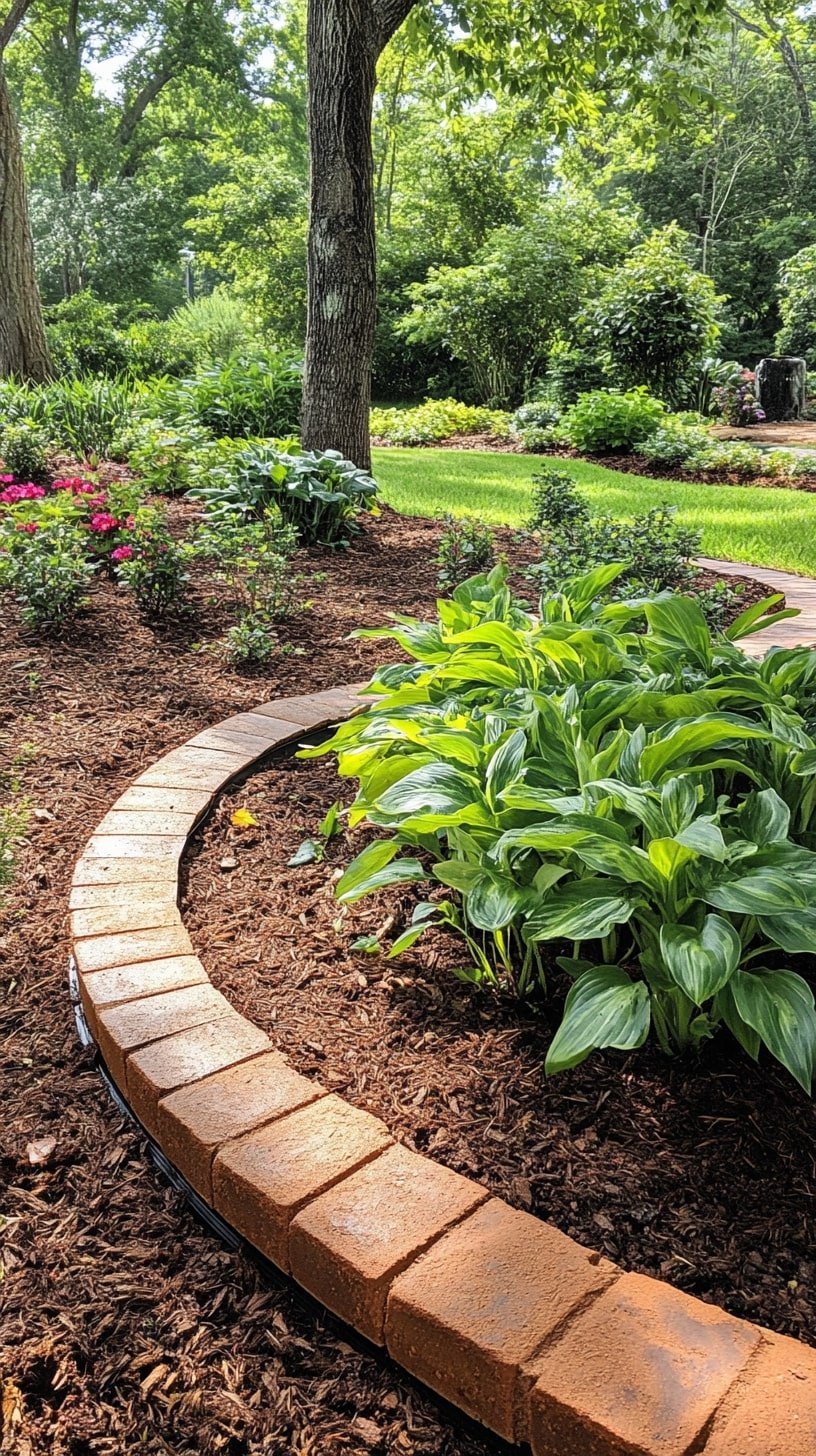
A clean curve of brick edging winds gently through this lush garden bed, creating a soft but defined boundary between the leafy greens and tidy mulch. The bricks are laid snugly side by side, forming a subtle yet polished path that flows naturally with the landscape.
Surrounding the brick edge, rich green hostas and blooming flowers bring texture and life to the garden floor. The warm brick tones contrast beautifully with the cool foliage, adding just enough structure without overpowering the natural charm of the space.
2. Brick Edging Installation Process with Trench and Sand Base
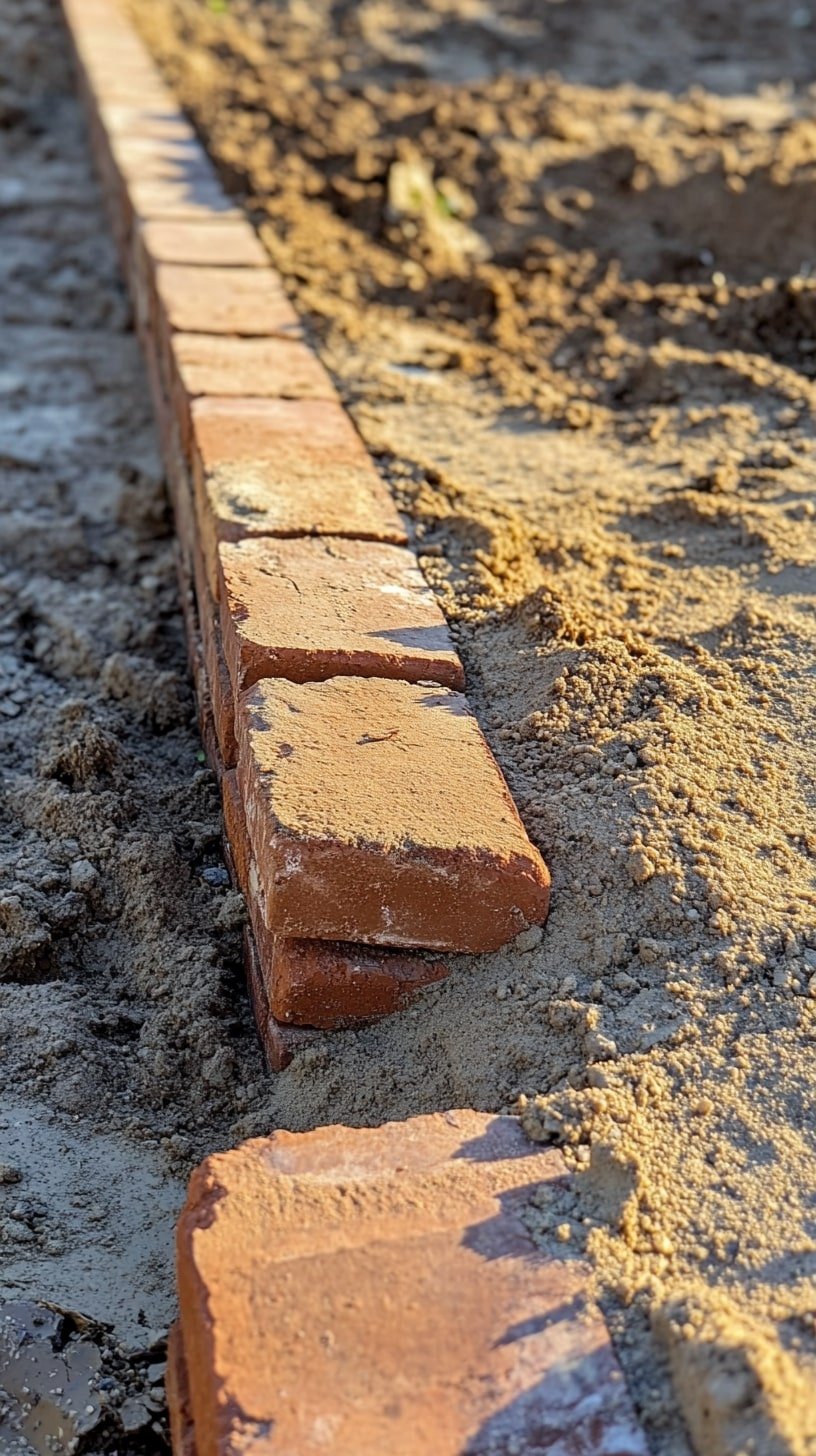
This image captures the hands-on process of laying brick garden edging, with a fresh row of bricks set snugly along a sand-filled trench. The rough edges and dusting of sand give it a real-time, in-progress feel that’s all about DIY simplicity.
Each brick is tightly aligned for a clean, straight finish, hinting at the careful planning behind even a modest border. The sandy soil serves as a firm yet flexible base, keeping the bricks level and stable as the layout takes shape.
3. Straight Brick Border Along Lawn and Concrete Walkway
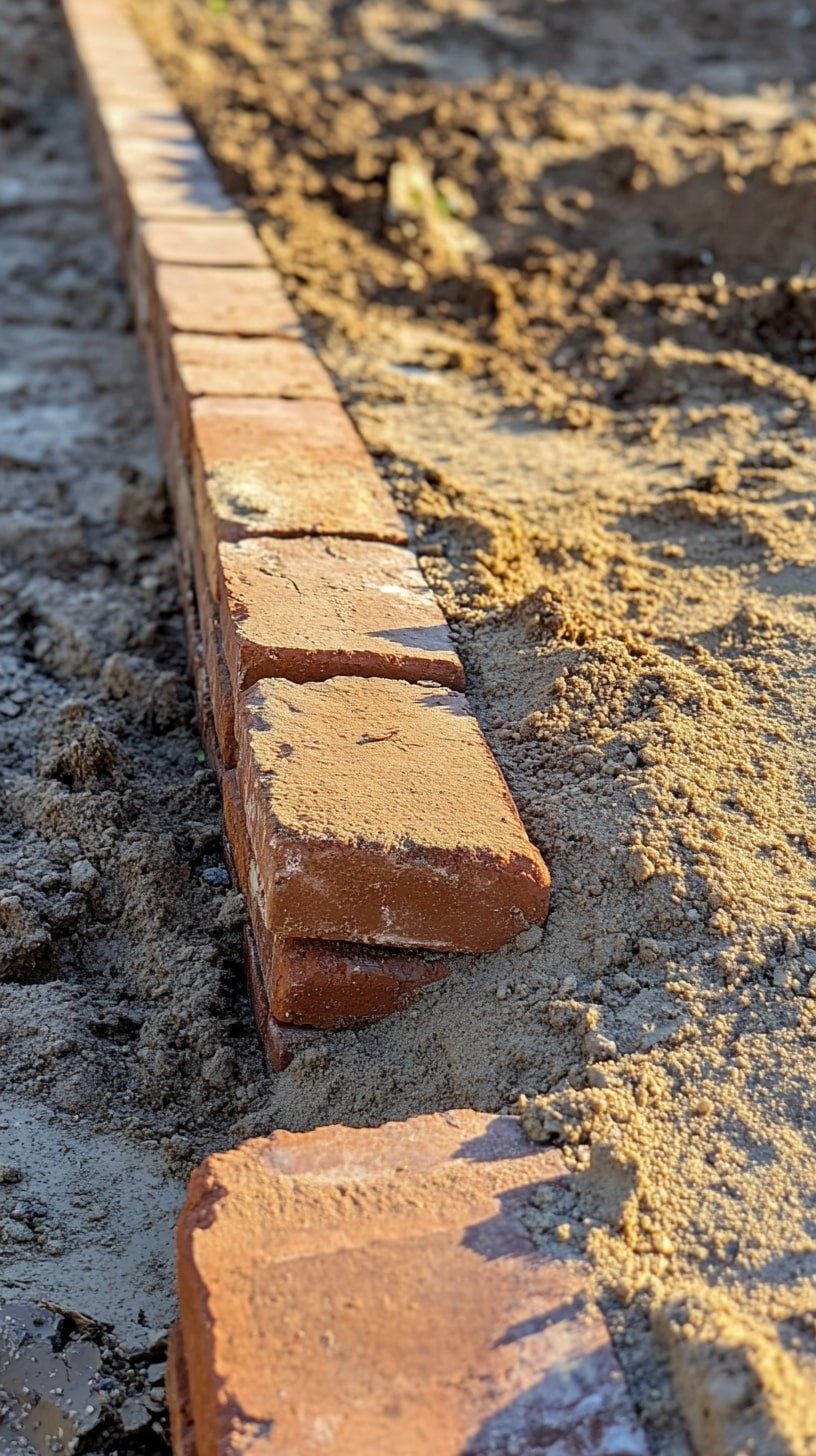
This image shows a clean row of bricks being laid in a straight line, nestled into a trench of compacted sand and soil. The golden afternoon light highlights the rough texture of each brick and the subtle variations in color, giving the scene a grounded, natural look.
The setup captures a simple yet effective edging method, where bricks are placed snugly side-by-side without mortar, relying on careful alignment and the stability of the sand base. It’s a great example of low-maintenance garden design that adds a crisp visual boundary to flower beds or paths.
4. Basket Weave Brick Pattern for Raised Garden Edging
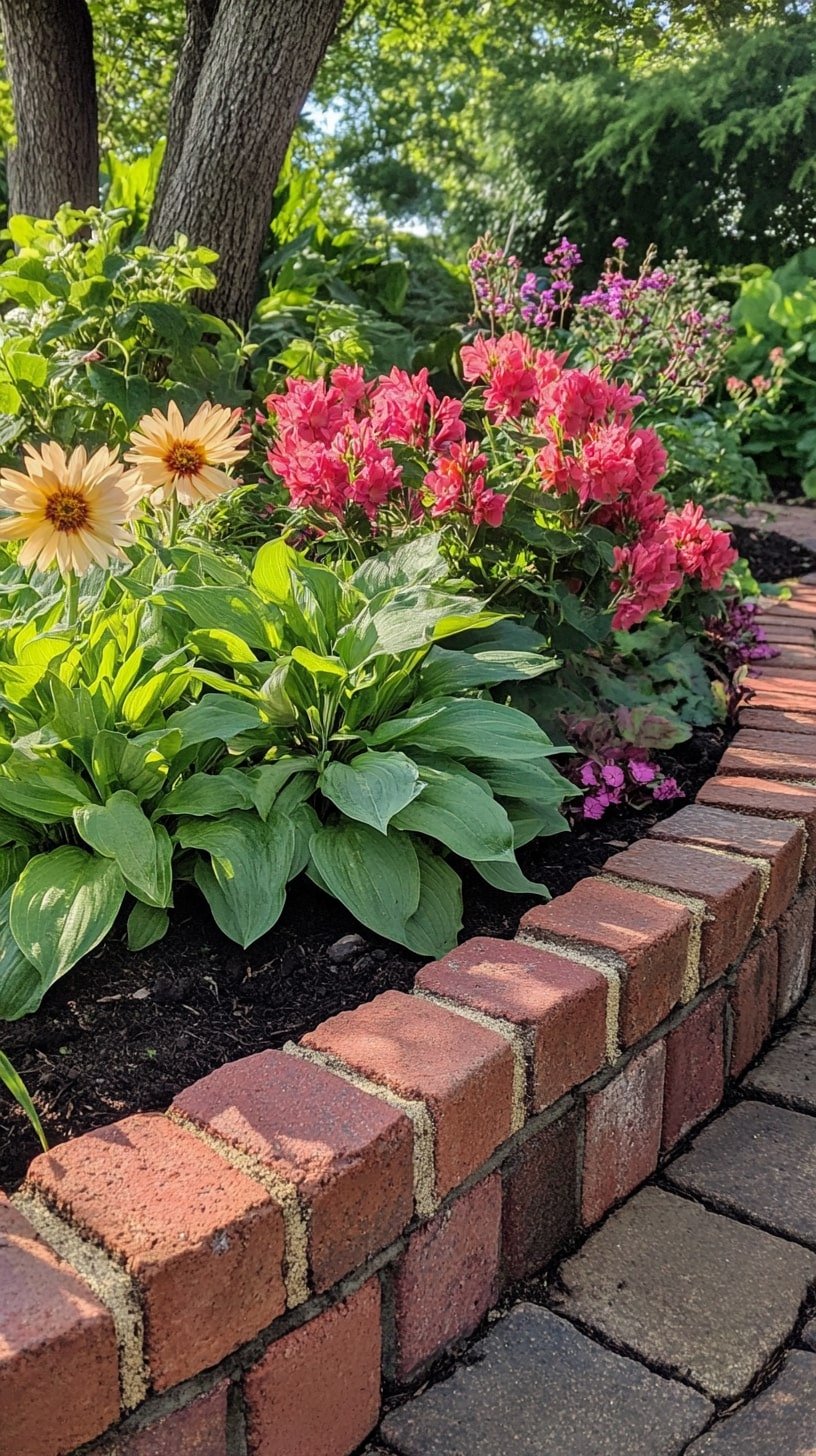
This charming raised brick edge creates a bold, defined border between the lush garden bed and the paved path. Set in a classic basket weave pattern, the bricks offer a rich, warm contrast to the deep greens of hostas and the vibrant pops of pink and yellow blooms.
The mortar-filled joints give the structure a more permanent, polished feel, enhancing both the aesthetic and functional appeal of the garden. It subtly lifts the flower bed, helping to contain mulch and soil while drawing the eye to the beautiful plantings.
5. Angled Brick Garden Edging with Gravel Pathway
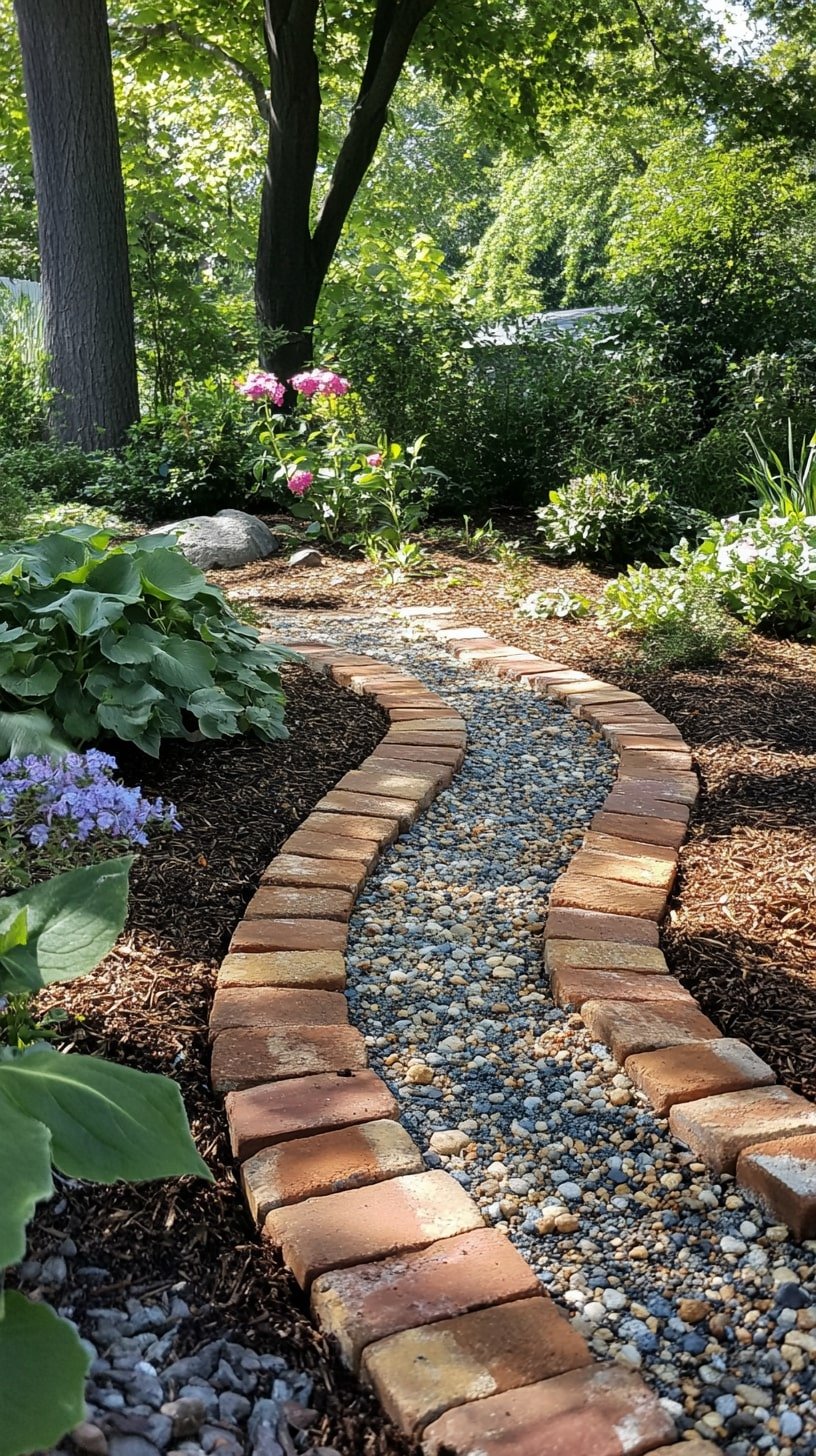
This winding garden path uses warm-toned bricks laid at an angle to create a distinctive, textured border. The bricks subtly guide the gravel trail through a mix of foliage, drawing the eye along the natural curve of the walkway. The edge feels rustic yet thoughtfully placed perfect for a relaxed, woodland-inspired garden.
The use of small river pebbles inside the path adds a grounding contrast to the bricks and prevents erosion, while mulch beds on either side keep things tidy. The soft interplay of organic shapes and hard materials creates a calm, approachable setting.
6. Brick-on-Edge Border with Mortared Finish
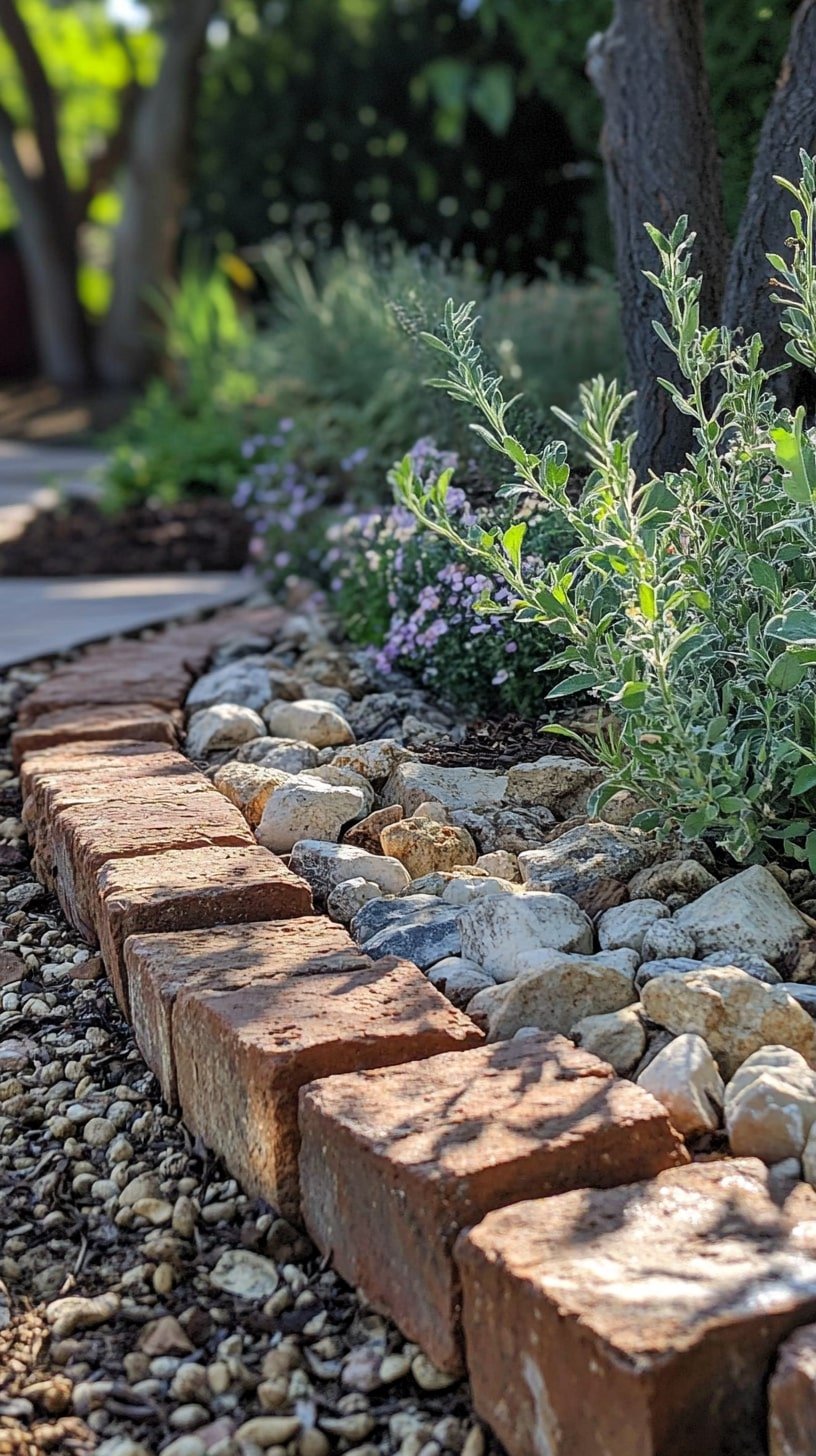
This image shows a tidy brick-on-edge border defining a low-maintenance garden bed. The bricks are placed vertically for a more structured, elevated look, contrasting nicely with the scattered river rocks inside the bed. It’s a clean, organized layout that still feels warm and natural.
The use of mixed stones adds visual interest while helping with drainage. Hardy greenery and soft purple blooms peek through, creating a relaxed planting scheme that works well in sunny spots. The path beside is lined with smaller gravel, echoing the natural textures in the bed.
7. Rustic Brick Border with Moss and Irregular Shapes
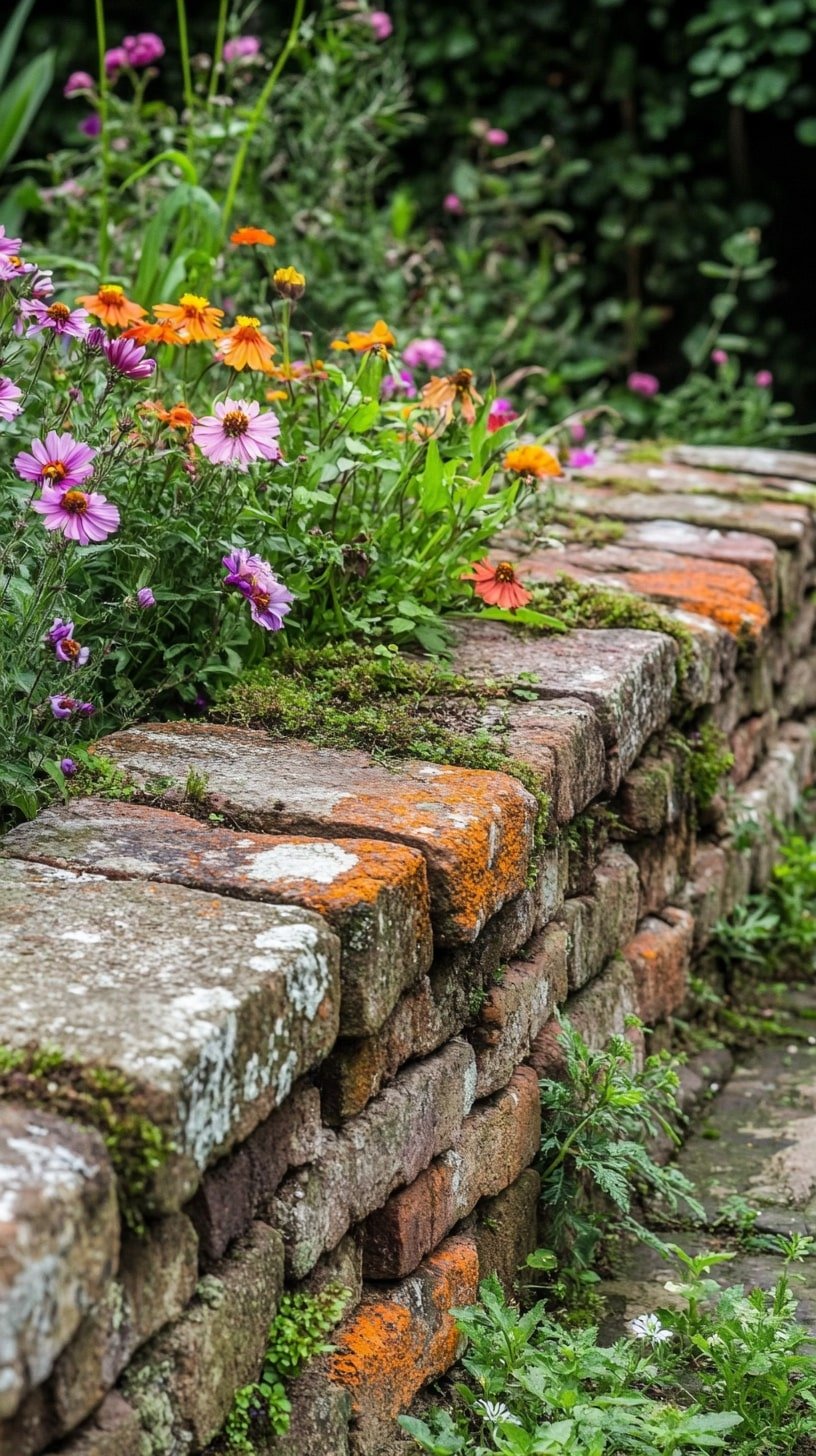
This image shows a tidy brick-on-edge border defining a low-maintenance garden bed. The bricks are placed vertically for a more structured, elevated look, contrasting nicely with the scattered river rocks inside the bed. It’s a clean, organized layout that still feels warm and natural.
The use of mixed stones adds visual interest while helping with drainage. Hardy greenery and soft purple blooms peek through, creating a relaxed planting scheme that works well in sunny spots. The path beside is lined with smaller gravel, echoing the natural textures in the bed.
8. Brick and Steel Combo Edging for Contemporary Garden
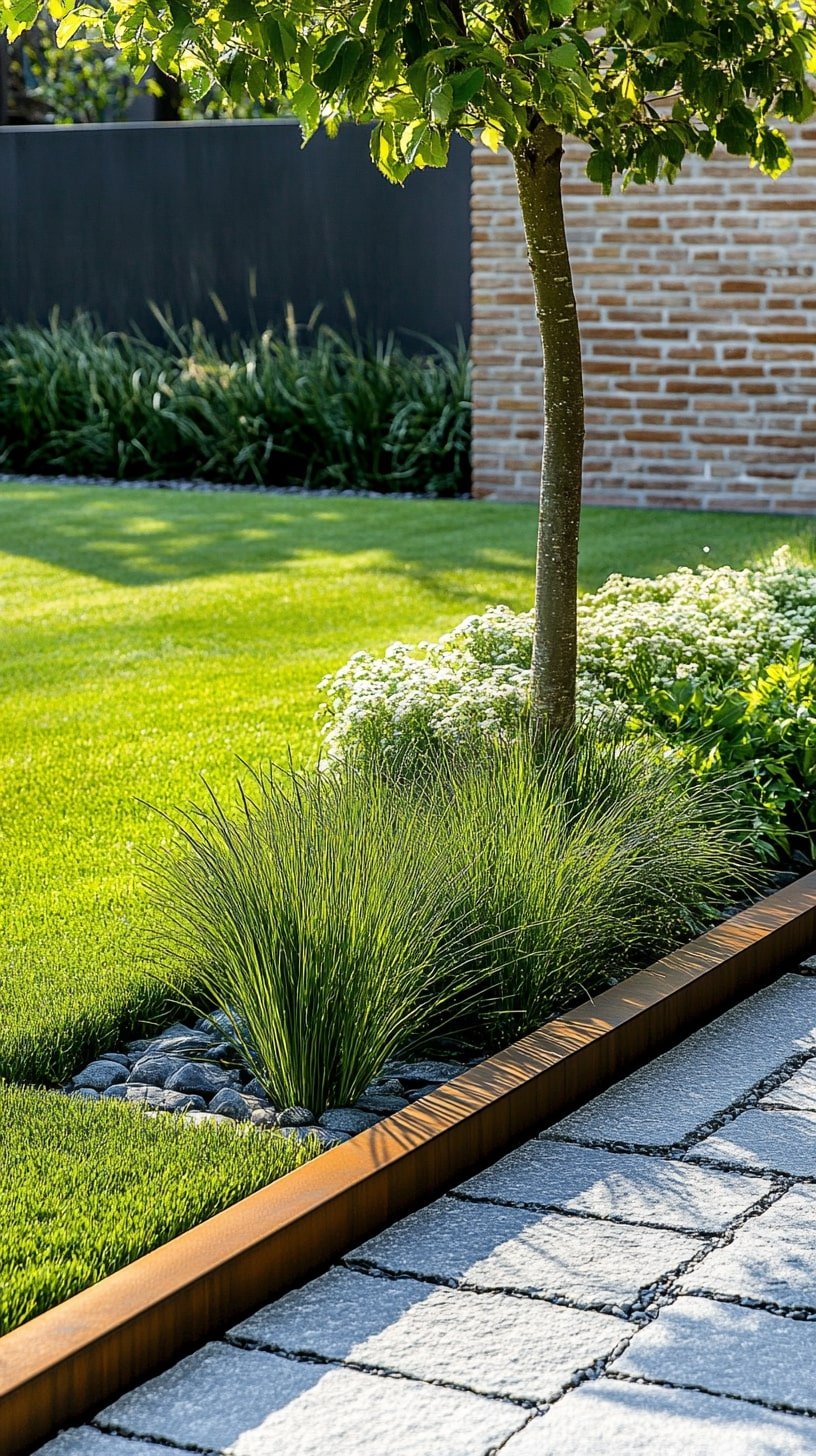
Aged bricks create a charming, timeworn border in this garden scene, where moss and lichen naturally soften the hard edges. The bricks are slightly irregular in shape and stacked loosely, giving the wall a rustic, old-world feel. The mix of green growth in the cracks adds texture and story to the structure.
Above the brick line, vibrant wildflowers in oranges, pinks, and purples tumble over the edge, spilling into view with a casual, cottage-garden vibe. The lush greenery beyond the blooms adds depth while maintaining the relaxed, overgrown look.
10. Laying Bricks with Level Tool and Sand Fill
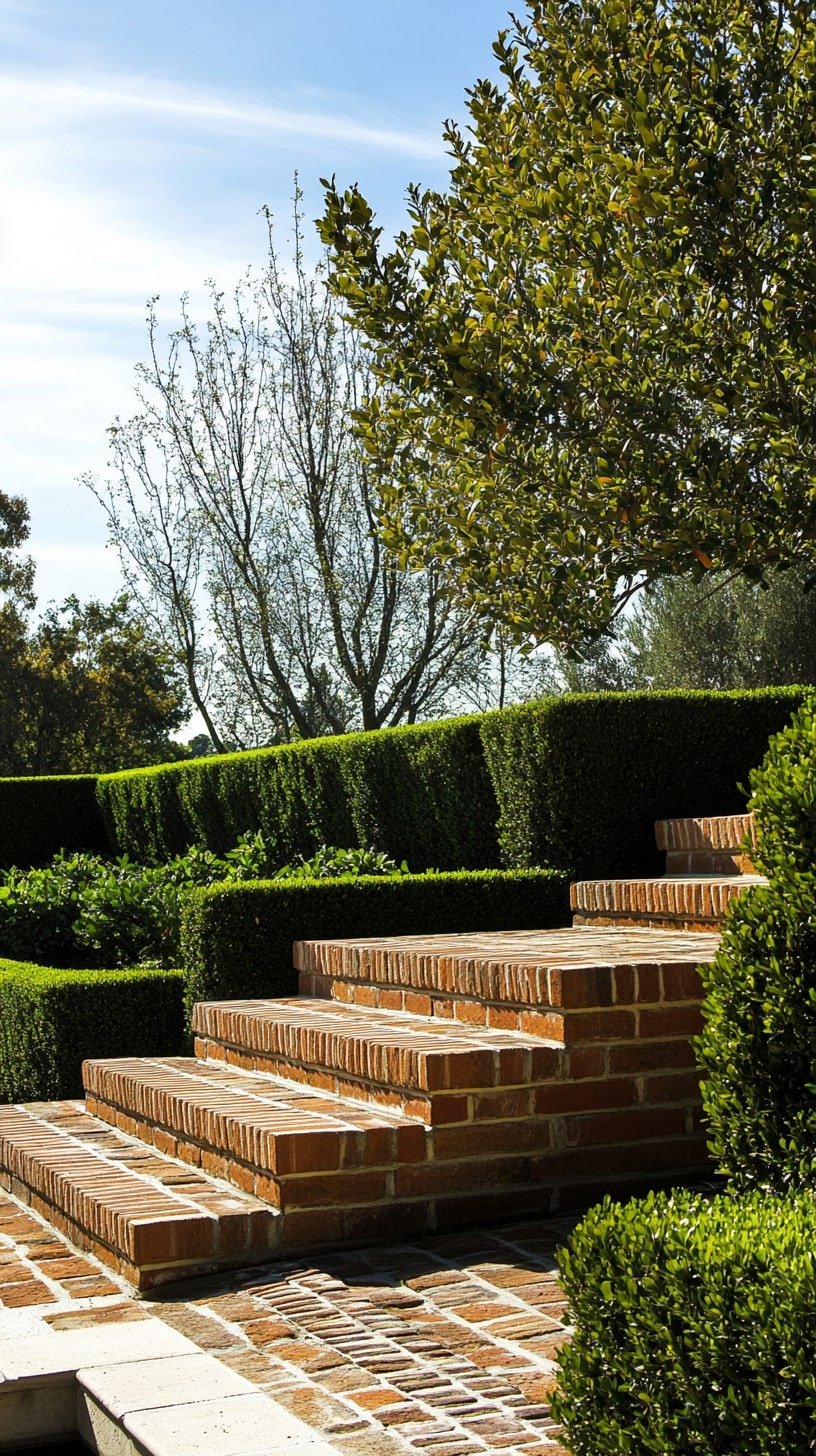
The image showcases a stately outdoor staircase made entirely of traditional red bricks, lending timeless charm to the surrounding garden. Each step is sharply defined, set against perfectly manicured hedges and layered greenery that bring balance to the rigid geometry. The rich brick tones feel grounded and classic beneath the bright sky.
Clean lines and repetition play a big role here. The brickwork doesn’t just form the steps it continues across the patio floor, connecting vertical and horizontal elements into one cohesive look. Lush topiary and boxwoods offer texture and contrast while still preserving the formal, tailored mood of the space.
11. Herringbone Brick Pattern Border for Pathway Edging
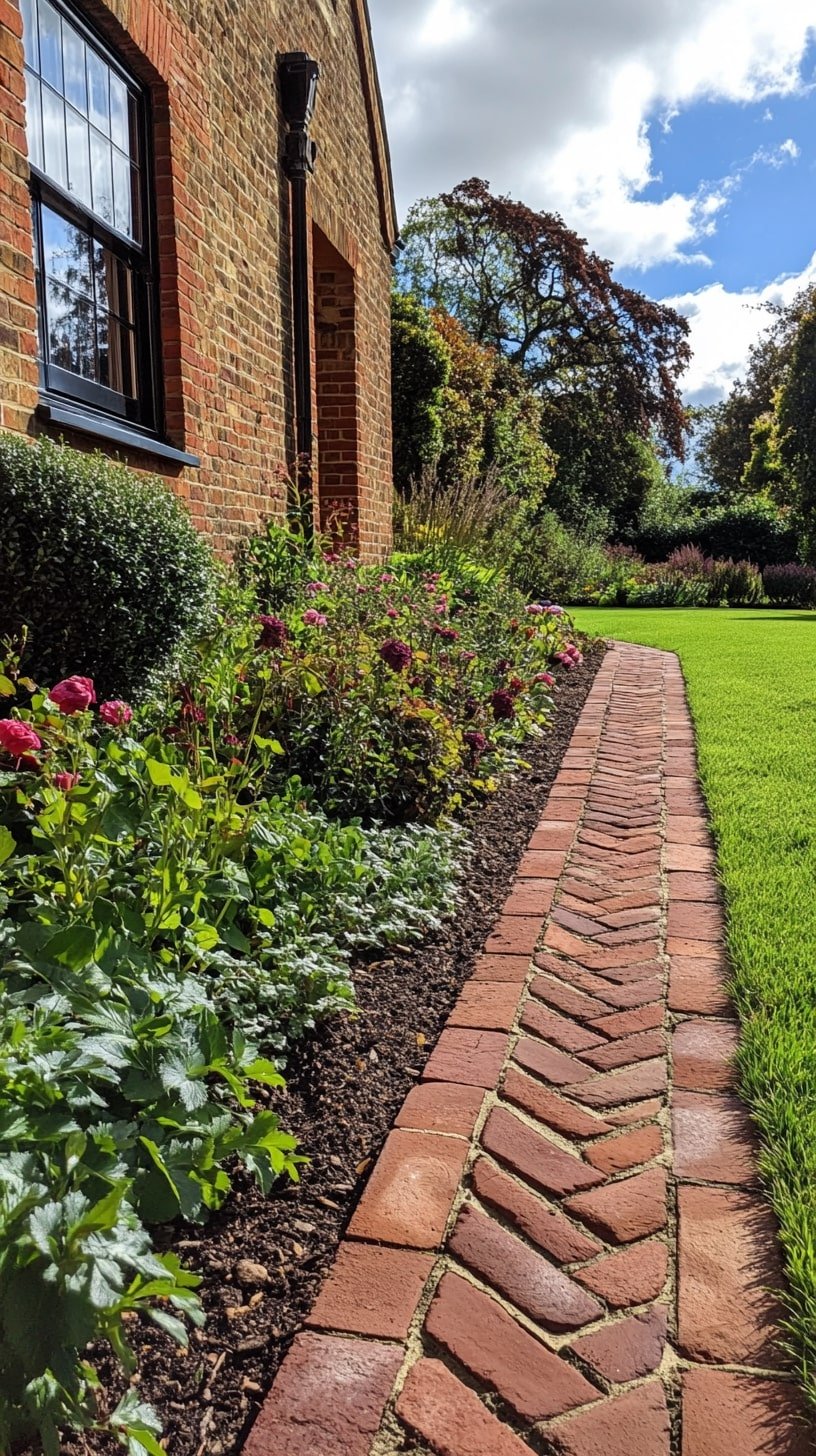
The image features a beautifully maintained garden bed lined with a herringbone-patterned brick path, running alongside a traditional brick house. The classic layout of the bricks creates a crisp, eye-catching design that complements the building’s exterior and draws the eye through the space. Neatly mulched soil and blooming pink roses soften the structure with a touch of color.
This border does more than divide flower beds from lawn it brings an intentional, tailored feel to the entire landscape. The precision of the brickwork adds texture and rhythm, echoing the symmetry found in formal English-style gardens. The overall effect is polished without being too rigid.
12. Circular Brick Edging Around Tree Base
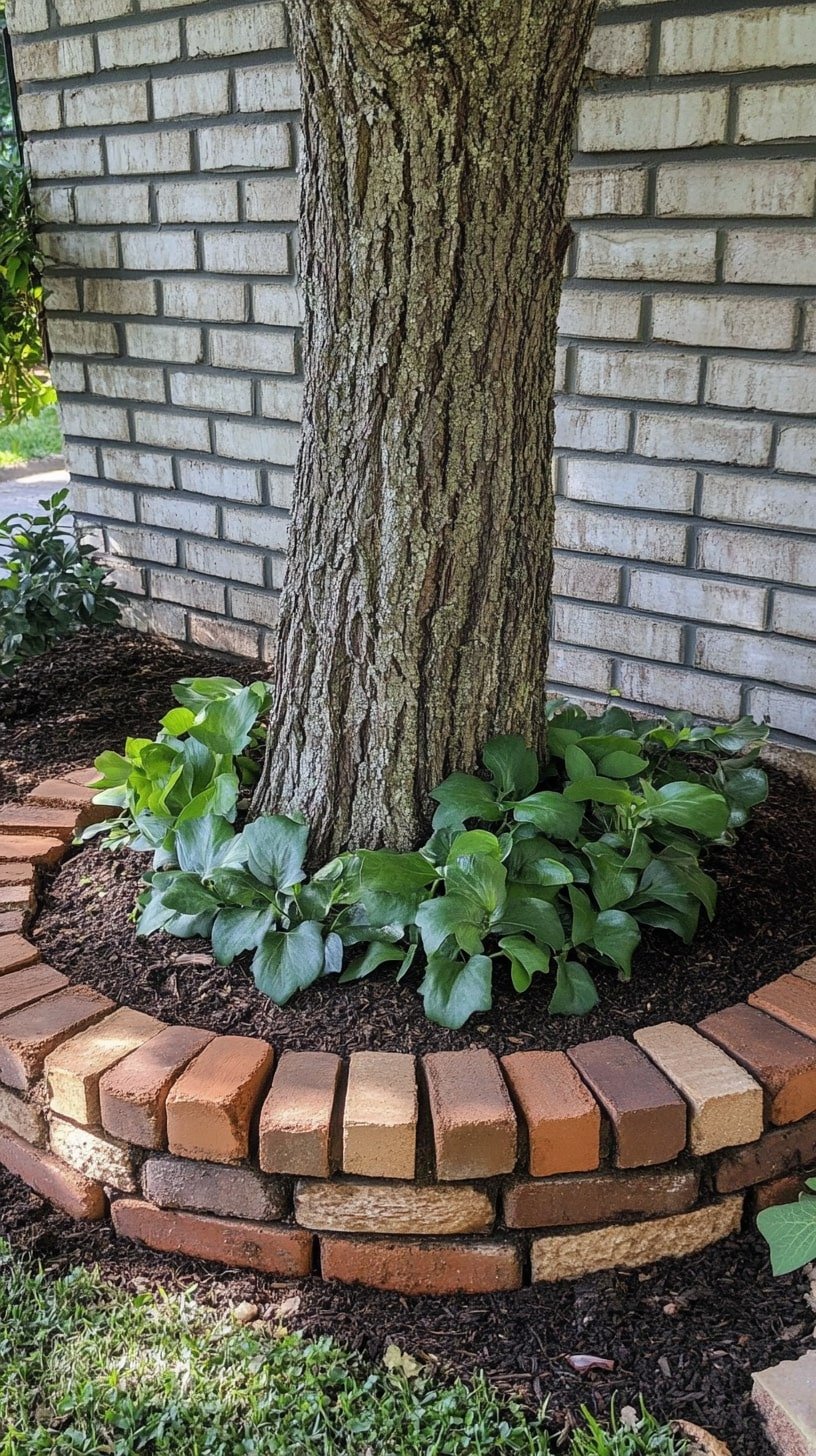
The image shows a simple yet charming circular brick border encircling the base of a mature tree. The bricks are stacked two layers high, alternating between earthy shades of terracotta, tan, and brown, creating a warm and textured contrast against the mulch. The raised edge helps contain the soil while showcasing the healthy green foliage planted beneath the tree’s canopy.
This type of edging serves both form and function. It frames the tree cleanly, prevents soil erosion, and visually separates the tree bed from the surrounding lawn. The color variation in the bricks adds subtle visual interest without overwhelming the natural tones of the landscape.
13. Brick Edge with Pebble Infill Between Path and Bed
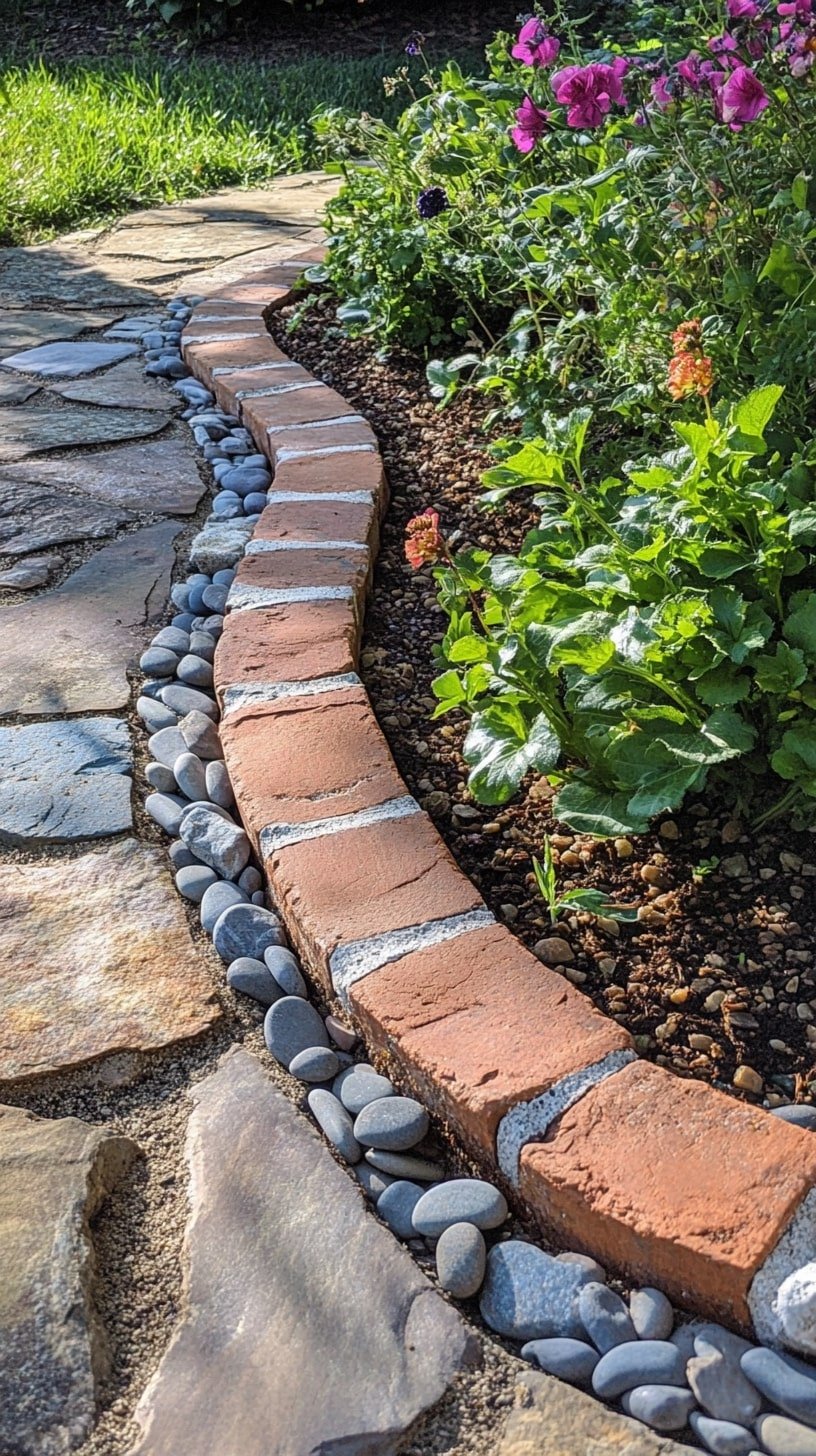
The photo highlights a beautifully crafted brick garden edge that smoothly curves between a flagstone path and a vibrant flower bed. Each brick is neatly mortared in place, and the space between the stones and bricks is filled with smooth river pebbles. This mix of textures gives the border a grounded, yet refined appearance.
What makes this edging stand out is the thoughtful combination of materials natural stone, brick, and polished pebbles each adding contrast in color and shape. The gray pebbles act as a transition between the warm brick and cool-toned flagstone, creating a clean and intentional separation without being harsh.
14. Side Garden with Thin Brick Edge and Perennials

The image captures a narrow garden bed bordered by a slim, neatly stacked brick wall running alongside a house. The bricks are laid in a simple, consistent pattern that contrasts gently with the vibrant flower bed and lush green lawn. The wall itself is just high enough to define the space without overwhelming the soft landscaping.
What stands out most is how the clean brick edge elevates the planting area, creating a tidy visual separation that also functions as a mini-retaining wall. The variety of colorful flowers spills slightly over the top, softening the structure and adding seasonal charm.
15. L-Shaped Brick Border in Modern Corner Garden
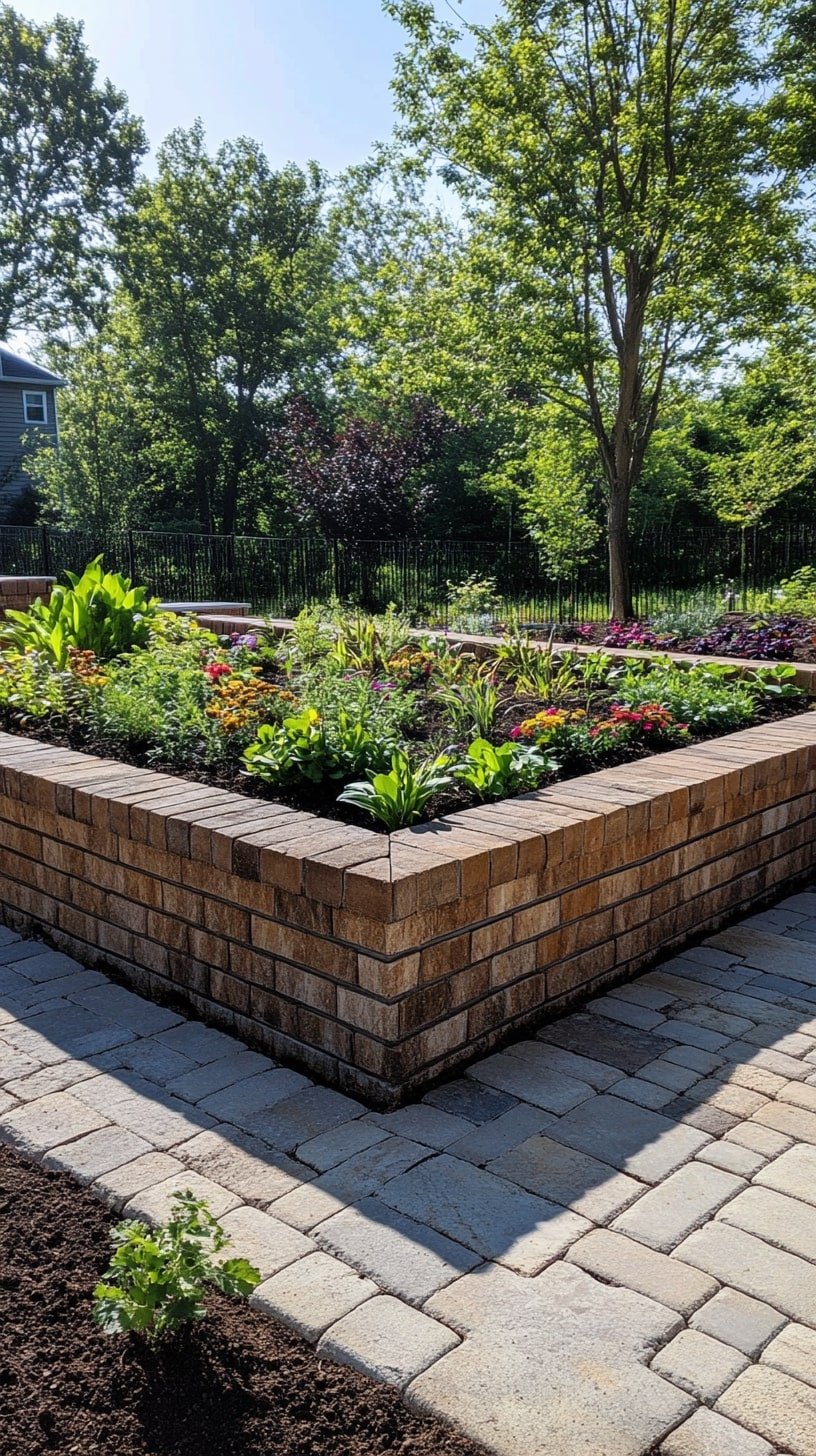
The image shows a raised, L-shaped garden bed crafted from stacked bricks in a neutral tone, forming a clean, angular border around a lush mix of colorful plants. The brickwork is neatly aligned and capped for a polished look, while the surrounding stone pavers provide a spacious walkway that enhances the bed’s structured form.
This setup is perfect for organizing a vibrant garden into a defined corner space. The elevation not only adds depth and dimension to the landscape but also improves drainage and makes gardening more accessible. It’s a great example of using hardscaping to frame nature with purpose and style.
16. S-Shaped Garden Edge with Bricks Set in Sand
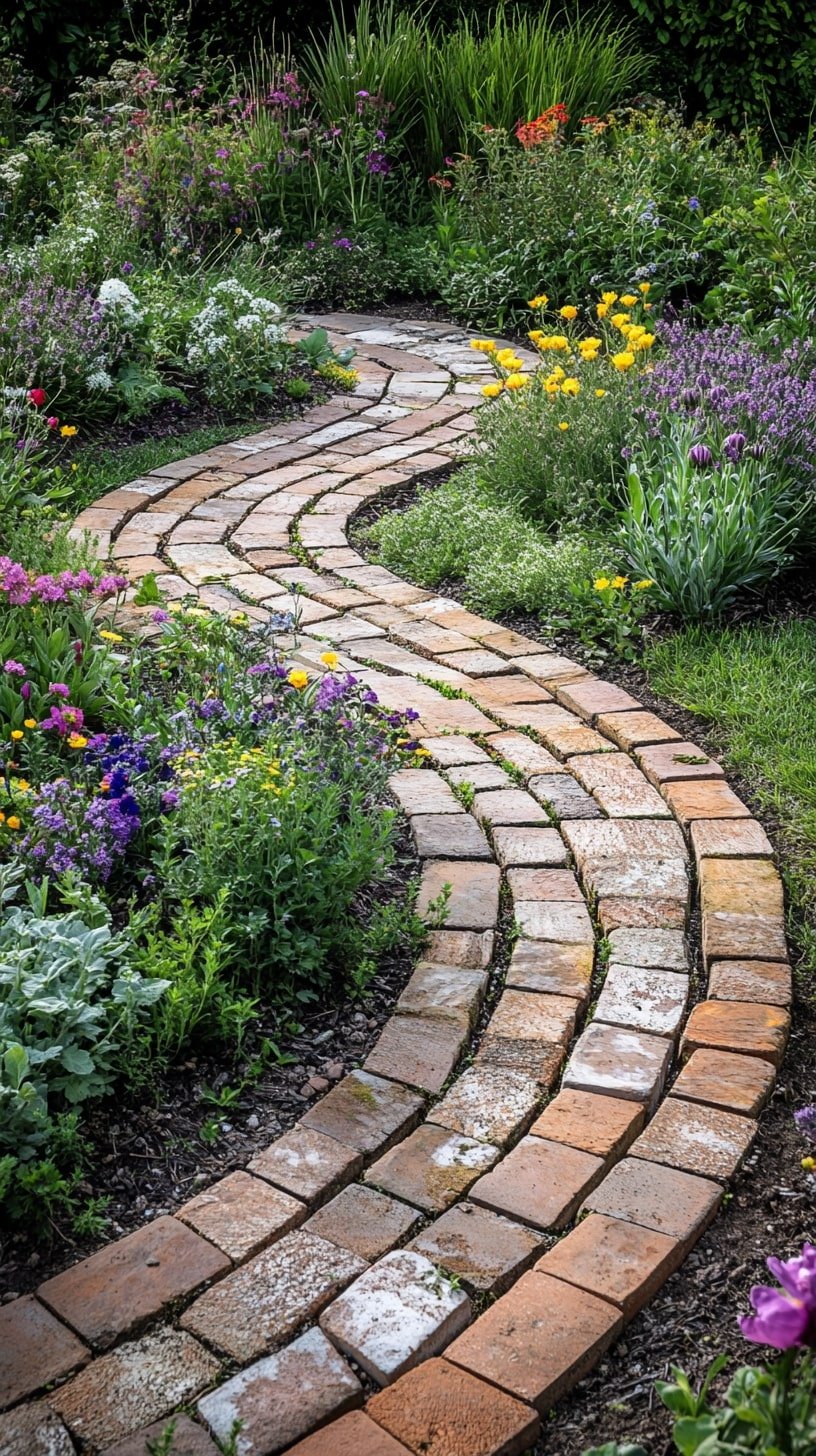
This curving garden path offers a charming stroll through lush flower beds, with brickwork laid in soft, flowing lines. The bricks are slightly weathered, giving the path a natural, lived-in feel that complements the untamed beauty of the surrounding blooms. Each turn in the S-shaped design invites a new view, drawing you deeper into the garden.
It’s the kind of detail that makes a garden feel alive and thoughtful. Instead of sharp angles, the path gently winds, creating a sense of movement and exploration. The mixture of old and new bricks adds visual interest without distracting from the flowers.
17. Stepped Brick Edging Down a Sloped Yard
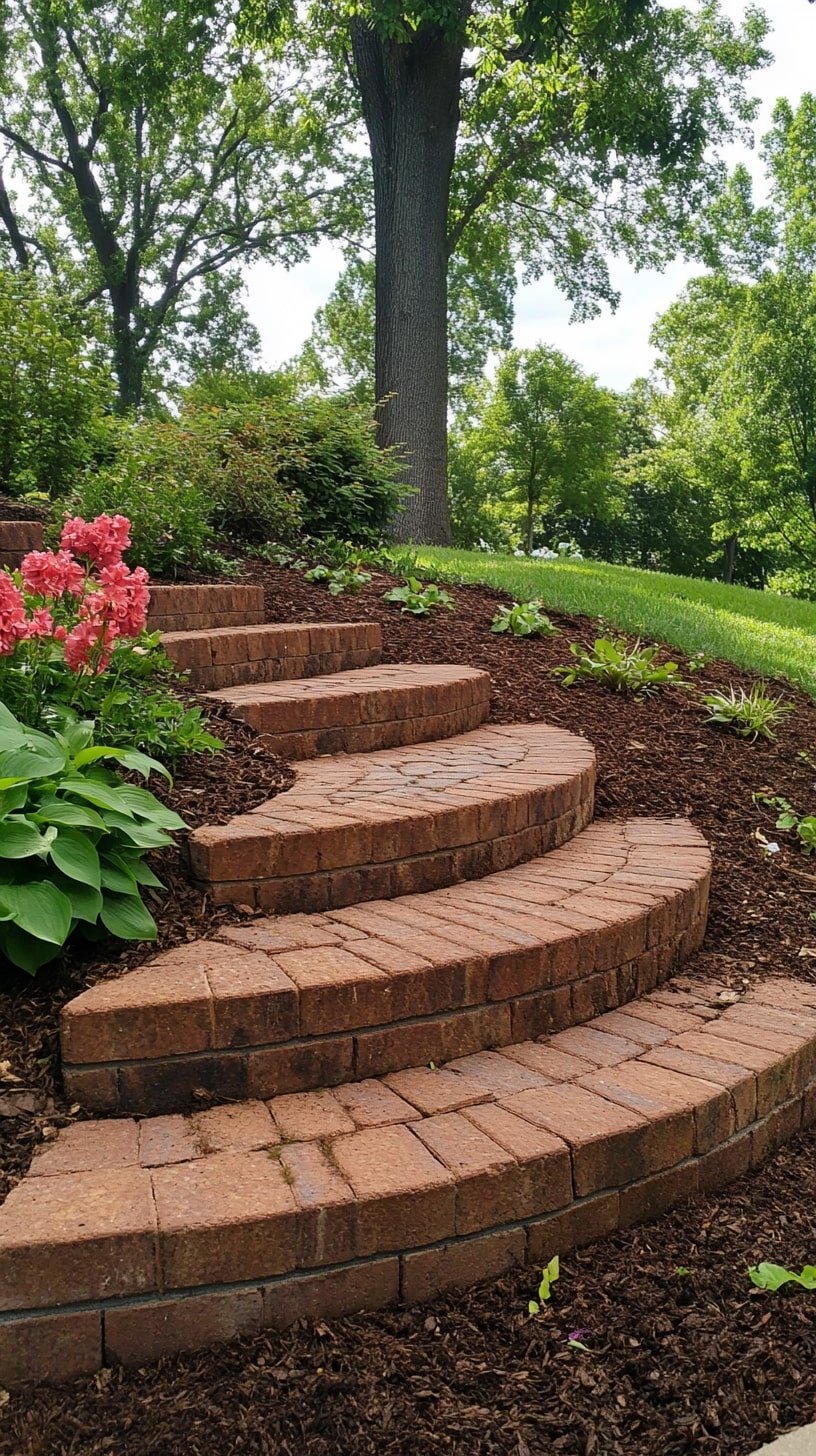
These gently curved brick steps are a beautiful way to manage a sloped garden while keeping a natural flow. Each step is crafted with warm-toned bricks and bordered neatly, blending seamlessly with the mulch and surrounding greenery. The subtle arc of the staircase softens the transition between levels, making the ascent feel organic and welcoming.
The design doesn’t just serve function it adds character. The even spacing and brick pattern create rhythm, while the tidy landscaping alongside enhances its inviting appearance. This layout helps guide the eye upward without breaking the harmony of the garden.
18. Old Brick Edging Reclaimed for Vintage Look
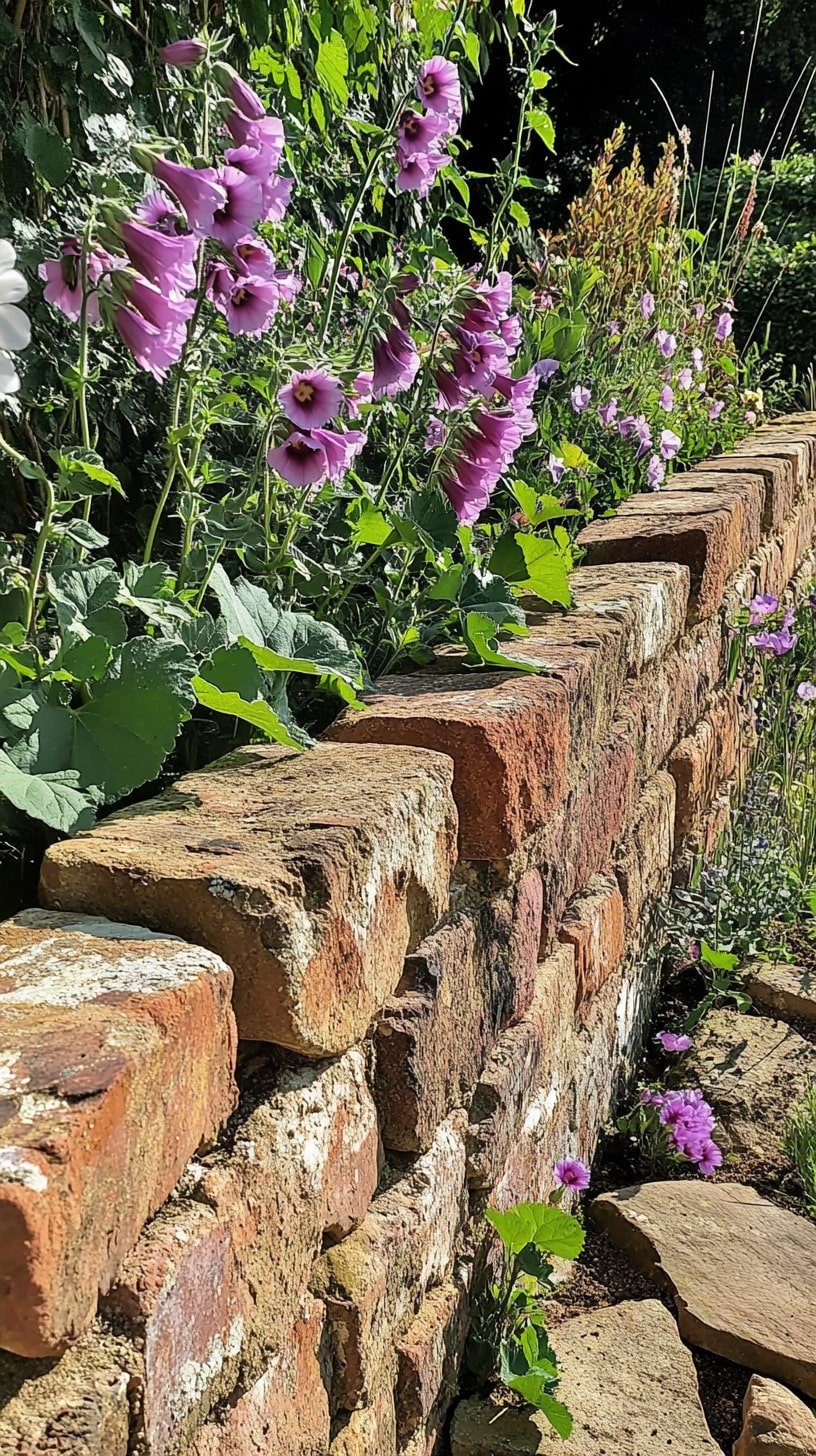
Weathered and full of charm, this reclaimed brick edging adds a timeless quality to the garden border. The irregular bricks, softened by age and patina, form a low wall that effortlessly blends into the lush flower bed behind it. Pale lavender blooms cascade just above the edge, creating a soft contrast to the rugged texture of the brick.
This type of border works especially well for cottage-style or vintage gardens. It not only holds soil in place on a slightly raised bed but also introduces a handcrafted, heirloom aesthetic. The slight color variations in each brick add depth and personality.
19. Brick Edging With Solar Lights for Night Garden Glow
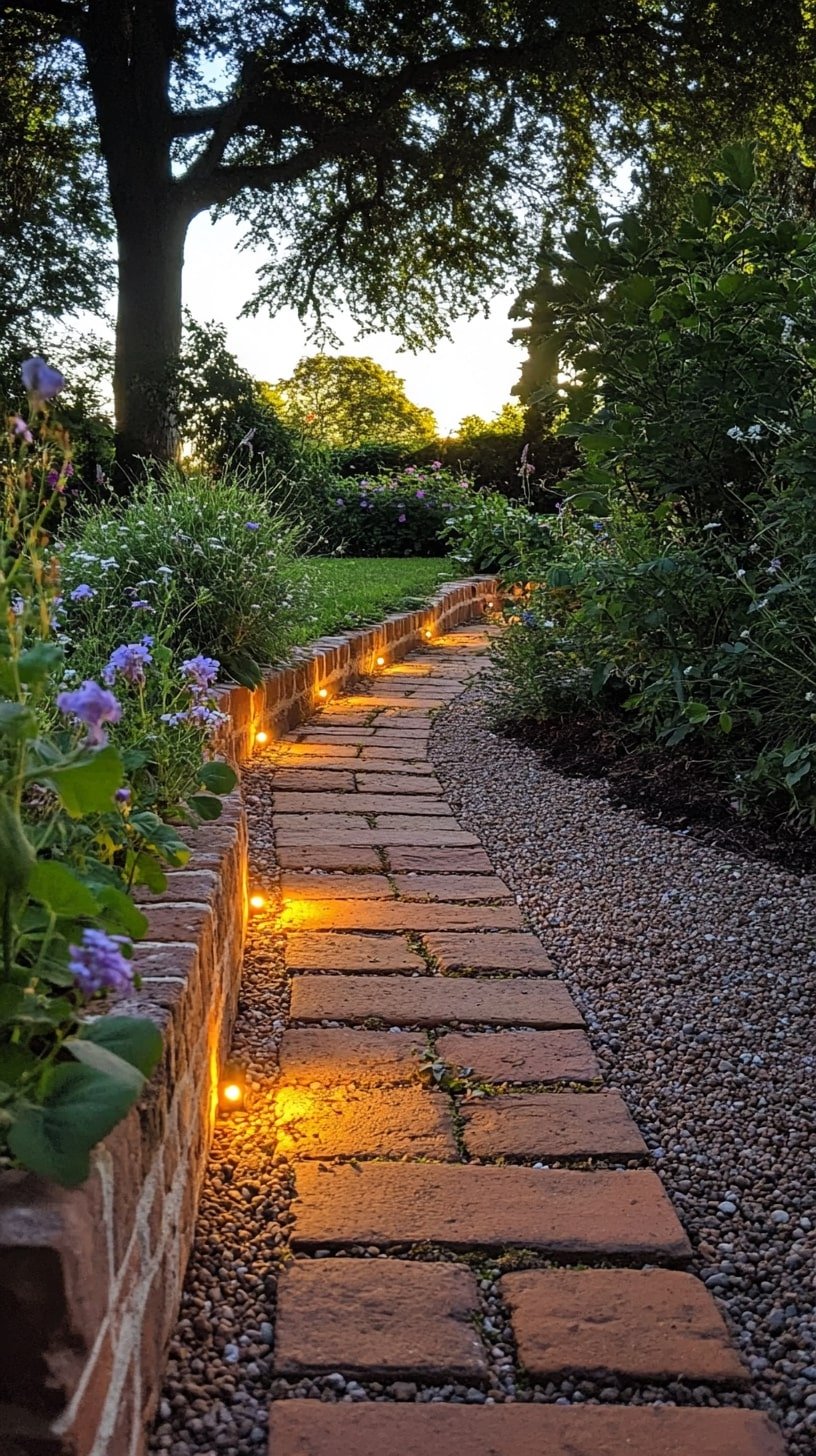
As twilight settles in, this brick garden path begins to glow with the soft amber light of integrated solar fixtures. Each brick step is lined by a low, neat edging wall that both frames the path and discreetly houses the gentle lights. Surrounded by delicate flowers and lush greenery, the space feels both magical and welcoming.
The warm tones of the bricks enhance the cozy evening atmosphere, while the lighting adds safety and charm. It’s a thoughtful detail that turns a simple walkway into a serene nighttime escape. The surrounding gravel adds texture and contrast underfoot.
20. Brick Edging with Concrete Backing for Stability
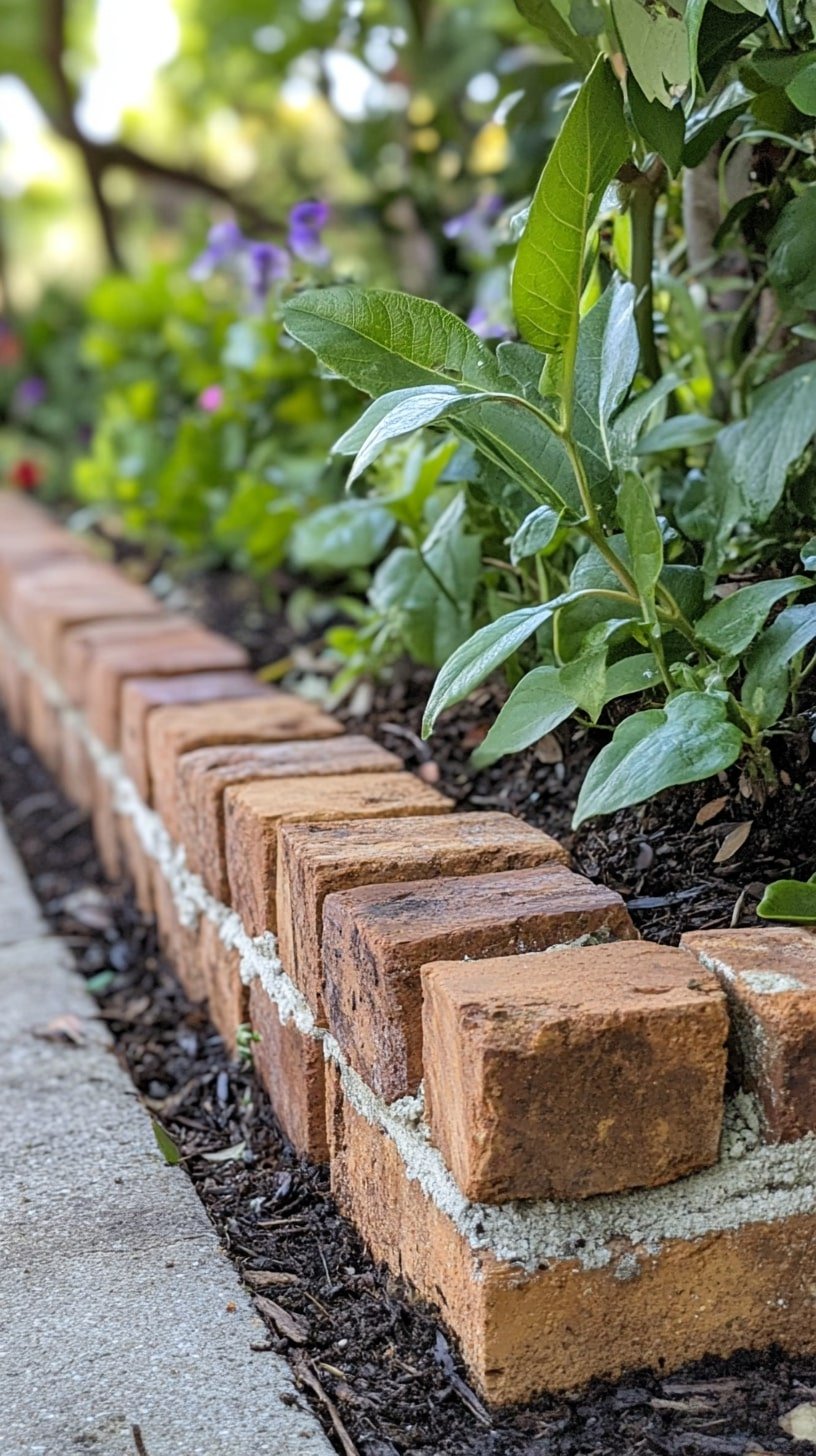
A neat row of upright bricks creates a tidy edge that visually separates the walkway from the garden bed. These bricks are set in a solid double layer of mortar, giving the edging both structure and long-term stability. The tight spacing and vertical layout lend a clean, intentional look that suits both classic and modern landscapes.
Each brick stands evenly, with just enough texture to soften the edge without losing its sharp form. This kind of edging is especially useful for keeping mulch and soil in place while making garden maintenance easier.

